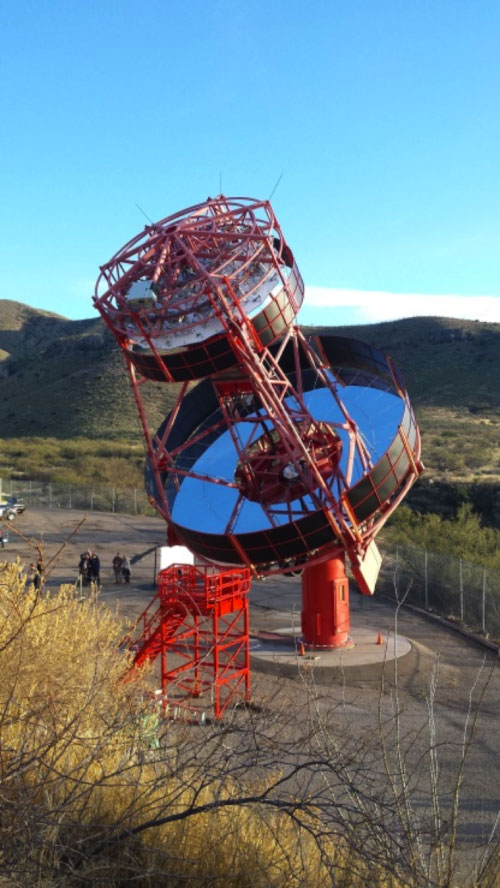Members of the upcoming international CTA (Cherenkov Telescope Array) project, two scientists from the Paris Observatory were invited to Arizona for the inauguration of a new American prototype.

Following the small French prototype developed on the Meudon site of the Paris Observatory, this new American model was created on the basis of the « Schwarzschild-Couder » two mirror technology ; the difference is that it is of intermediate size.
Destined for the study of cosmic gamma radiation,, CTA is one of the most ambitious ground based projects of the XXIst century.
This upcoming observatory will in the end involve a flotilla of 118 telescopes on the Earth’s surface. Involving three different sizes : small, medium, large, the telescopes will be grouped in two networks : one will be in the northern hemisphere, and the other in the southern hemispherer.
Various kinds of technology are currently being tried, via a number of prototypes.
The advantages of a « Schwarzschild-Couder » two mirror type technology
The two mirror idea was proposed a in the last century by Karl Schwarzschild (1873-1916), and was subsequently optimized by André Couder (1897-1979) who was at that time an optical astronomer at the Paris Observatory.
Before the birth of the CTA project, the « Schwarzschild-Couder » two mirror technology had never been tried in astronomy. There were various reasons for this, and notably the technical difficulties of making aspherican and not conical mirrors. However, this technology is theoretically capable of reaching the theoretical limit of « gamma ray » astronomy.
Astronomers became interested in this technology for the CTA optical telescope system since it leads to a significant improvement in the quality of wide field images, compared to the single mirror telescopes used till now for ground based gamma ray astronomy.
In effect, the secondary mirror corrects the aberrations and reduces the scale of the sensitive surface in the focal plane. There is another advantage : it also enables one to use the new silicon photo-multipliers (SiPM), which are well adapted for this purpose and are cheaper than the traditional photo-mulipliers.
With the inauguration of this new prototype in the U.S.A., the number of Schwarzschild-Couder type telescopes installed in the world for the CTA has now increased to three : this includes the French prototype inaugurated at Meudon in 2015 as well as a 4m Italian prototype installed on the slopes of Etna.


The overall CTA project
The construction of the infrastructure in the Southern hemisphere, in Chile, will begin in 2019, after the official signatures have taken place end December 2018.
This southern section of the network will consist of 99 telescopes, out of a total of 118 :
- 4 large (23 m de diamètre) telescopes,
- 25 intermediate size (9 to 12 m diametre) telescopes,
- 70 small size (4 m diametre) size telescopes.

The rest will be installed in the northern hemisphere, in Spain and in the Canary Islands, on the La Palma site, and will include 19 telescopes :
- 4 large size telescopes
- 15 intermediate size telescopes.
Already the very first large size telescope has been officially selected for the southern hemisphere CTA and was set up in the Canary Islands in 2018.
31 institutes are contributing to the CTA, including over 200 institutes world-wide.

